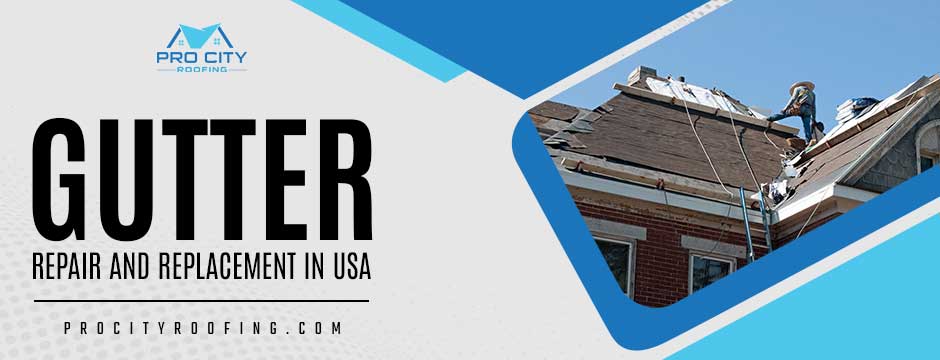Gutters play a crucial role in protecting our homes from water damage by efficiently channeling rainwater away from the roof and foundation. However, weather conditions can significantly impact the performance and durability of gutters. In this blog, we will explore how various weather conditions affect gutter damage and discuss when it is essential to seek repairs. By understanding these factors from gutter repair and replacement experts, homeowners can take proactive steps to maintain their gutters and prevent costly water-related issues.
How Rainfall Affects Gutters
When heavy rainstorms hit, gutters face a significant amount of water. The excess water can overload and strain the gutter system, leading to potential issues. Gutters may not be able to handle the excessive water volume, resulting in overflow and subsequent water damage to the roof, siding, and foundation of the house.
To prevent such problems, homeowners should prioritize proper gutter repair and replacement in New jersey during rainy seasons. This includes clearing debris, such as leaves and twigs, to avoid clogs that impede water flow. Regular inspections should also be conducted to ensure gutter alignment and stability.

1. Freezing Temperatures and Gutter Damage
During colder months, freezing temperatures pose a unique challenge to gutters. The formation of ice dams is a common issue, where melted snow or ice refreezes at the edge of the roof, creating a barrier that prevents proper drainage. The weight of ice dams can cause gutters to sag, detach, or even collapse.
Additionally, the expansion and contraction of gutter materials due to freezing and thawing cycles can lead to cracks, leaks, and other forms of damage.
Homeowners should be vigilant for signs of gutter damage caused by freezing temperatures. These include cracks, leaks, or detached sections of the gutter, as well as sagging or misaligned gutters. Prompt action is necessary to prevent further deterioration and potential water infiltration into the home.
2. High Winds and Gutter Problems
Strong winds can wreak havoc on gutters, particularly during severe storms or hurricanes. The force of the wind can loosen or detach gutter components, including fasteners and brackets. As a result, the gutter system becomes compromised, unable to effectively redirect water away from the house.
According to our gutter repair and replacement in USA experts, to identify wind-related gutter issues, homeowners should perform visual inspections after storms or periods of high winds. Loose or damaged parts should be repaired or replaced promptly to ensure the gutters’ optimal functionality. Listening for rattling or flapping sounds during windy conditions can also indicate loose or improperly secured gutters.
3. Extreme Heat and UV Rays
While heat and UV rays may not be as immediately noticeable as other weather conditions, they can still impact the longevity and integrity of gutters. Prolonged exposure to extreme heat and UV rays can cause gutter materials to deteriorate and weaken over time. This deterioration may result in cracks, sagging, or other structural issues.
Moreover, intense UV rays can cause the fading or discoloration of gutter finishes, affecting the aesthetic appeal of the home. Regular inspections should be conducted to identify signs of gutter damage caused by heat and UV exposure.

When to Seek Gutter Repairs
Regular gutter repair and replacement in New Jersey are crucial to ensuring optimal performance and longevity after gutter installation. Homeowners should proactively address gutter damage to prevent further issues and potential water damage to their homes.
Some warning signs that indicate the need for gutter repairs include:
- Leaking or overflowing gutters: Water leaks or overflowing gutters during rain indicate blockages, clogs, or damaged gutters that require immediate attention.
- Visible cracks, holes, or rust on gutters: Inspect gutters regularly for any visible signs of damage. Cracks, holes, or rust should be addressed promptly to prevent water leakage and further deterioration.
- Loose or sagging gutters: Gutters that are sagging or pulling away from the house indicate improper installation or damage to the fasteners. These issues should be resolved to maintain the gutters’ stability and functionality.
Conclusion
Weather conditions have a significant impact on the performance and durability of gutters. Heavy rainfall, freezing temperatures, high winds, and extreme heat can all contribute to gutter damage and compromise their ability to protect homes from water infiltration. Homeowners should prioritize regular gutter repair and replacement, inspections, and timely repairs to prevent costly water-related issues.
By understanding the effects of weather conditions on gutters and knowing when to seek repairs, homeowners can ensure their gutter systems remain in optimal condition, safeguarding their homes for years to come. Remember, seeking professional assistance for gutter repairs and maintenance can provide expert guidance and long-term solutions to maintain the integrity of your gutters. Want to find out more? Visit us at ProCity Roofing!